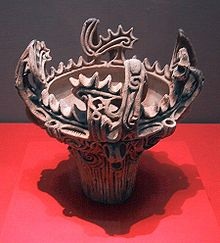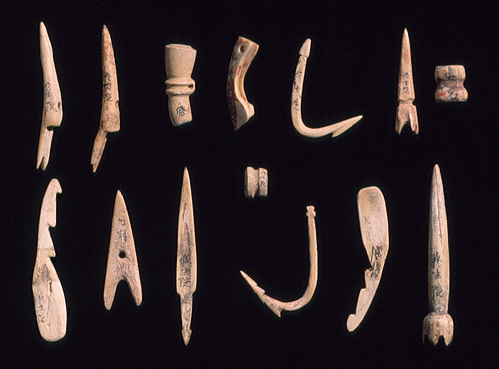Case Study
The Jomon Culture
|
The Jomon period, or the culture encompassing Neolithic Japan, derives its name from the characteristic "cord markings" that appeared on this culture's pottery. Although the Jomon culture consisted of mostly gathering and hunting people, the lifestyle was predominantly sedentary. As stated in the overview for this section, the Jomon relied upon various tools to adapt to the resources that geography provided them.
The Jomon period occupied several thousands of years, and is thus, divided into six smaller phases. Incipient Jomon - (10,500-8000 B.C.E) This phase provided the world with the earliest examples of pottery, including basic coil pots. Initial Jomon - (8000-5000 B.C.E.) In this phase, as a consequence of global warming, food was becoming more and more abundant. In order to better access this food, the Jomon developed tools such as stone grinding blocks, knives, and axes. Early Jomon - (5000-2500 B.C.E.) Tools in this phase included handicrafts. This encompassed the signature cord-like ceramics (such as cooking vessels), woven baskets, bone needles, and even more stone tools. Middle Jomon - (2500-1500 B.C.E.) As the world's climate continued to rise, more and more humans migrated to the mountains, where they interacted with the environment through the continuation of hunting and fishing. In this time period, more and more projectile weaponry was produced in order to accompany the hunting and fishing lifestyle. Late Jomon - (1500-1000 B.C.E.) Once again, climate change caused the Jomon people to migrate from the mountains to coastal regions. Because humans began to rely more and more upon the water, new fishing innovations were created. This included the toggle harpoon, and perhaps on of the Jomon culture's greatest achievements - some of the first canoes and paddles. Final Jomon - (1000-300 B.C.E) As the climate cooled even more, food became scarce. The Jomon people were unable to make adaptions to their environment, and eventually, the population swindled. As seen by the wide array of tools used by the Jomon throughout history, the ability to survive and flourish can be highly attributed to constant innovation. Through such innovations as the canoe, the Jomon were allowed to fish more efficiently, and through the creation of pottery, people used resources in creative and helpful ways. Thus, the importance of tools to the Jomon culture is clear: without the use of tools, the culture would have developed differently, or not at all. |
|
Works Cited
"Fishing Techniques of the Jomon People May Have Diffused from Fishermen of the Wallacea-Spice Islander / Sundaland-Sahul region." Heritage of Japan. N.p., n.d. Web. 05 Oct. 2012. <http://heritageofjapan.wordpress.com/just-what-was-so-amazing-about-jomon-japan/ways-of-the-jomon-world-
2/gone-fishing/fishing-techniques-of-the-jomon-people-may-have-diffused-from-fishermen-of-the-wallacea-spice-islander-sundaland-sahul-region/>.
"Heilbrunn Timeline of Art History." Jomon Culture (ca. 10,500–ca. 300 B.C.). The Metropolitan Museum of Art, 2012. Web. 05 Oct. 2012.
<http://www.metmuseum.org/toah/hd/jomo/hd_jomo.htm>.
Needles, Hooks, and Harpoons. N.d. Photograph. The Metropolitan Museum of Art, New York. The Metropolitan Museum of Art. Web. <http://www.metmuseum.org/toah/works-of-art/1975.268.333-345>.
2/gone-fishing/fishing-techniques-of-the-jomon-people-may-have-diffused-from-fishermen-of-the-wallacea-spice-islander-sundaland-sahul-region/>.
"Heilbrunn Timeline of Art History." Jomon Culture (ca. 10,500–ca. 300 B.C.). The Metropolitan Museum of Art, 2012. Web. 05 Oct. 2012.
<http://www.metmuseum.org/toah/hd/jomo/hd_jomo.htm>.
Needles, Hooks, and Harpoons. N.d. Photograph. The Metropolitan Museum of Art, New York. The Metropolitan Museum of Art. Web. <http://www.metmuseum.org/toah/works-of-art/1975.268.333-345>.


